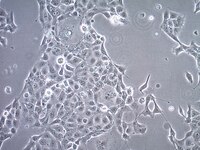SCC426 Sigma-AldrichHCC827 GR6 Human Lung Adenocarcinoma Cell Line
Recommended Products
Overview
| Replacement Information |
|---|
| References |
|---|
| Product Information |
|---|
| Biological Information | |
|---|---|
| Cell Line Type |
|
| Physicochemical Information |
|---|
| Dimensions |
|---|
| Materials Information |
|---|
| Toxicological Information |
|---|
| Safety Information according to GHS |
|---|
| Safety Information |
|---|
| Packaging Information | |
|---|---|
| Material Size | ≥1X10⁶ cells/vial |
| Transport Information |
|---|
| Supplemental Information |
|---|
| Specifications |
|---|
| Global Trade Item Number | |
|---|---|
| Catalogue Number | GTIN |
| SCC426 | 04065266515657 |
Documentation
HCC827 GR6 Human Lung Adenocarcinoma Cell Line SDS
| Title |
|---|
Data Sheet
| Title |
|---|
| Data Sheet-SCC426 |








